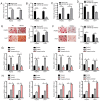MicroRNA-506-3p targets SIRT1 and suppresses AMPK pathway activation to promote hepatic steatosis
- PMID: 34707711
- PMCID: PMC8543238
- DOI: 10.3892/etm.2021.10865
MicroRNA-506-3p targets SIRT1 and suppresses AMPK pathway activation to promote hepatic steatosis
Erratum in
-
Erratum: MicroRNA-506-3p targets SIRT1 and suppresses AMPK pathway activation to promote hepatic steatosis.Exp Ther Med. 2022 May 23;24(1):463. doi: 10.3892/etm.2022.11390. eCollection 2022 Jul. Exp Ther Med. 2022. PMID: 35747148 Free PMC article.
Abstract
Nonalcoholic fatty liver disease (NAFLD) is a complex type of liver disease that represents an important global health threat. The mechanistic basis of this disease remains incompletely understood. The present study sought to explore whether microRNA (miR)-506-3p served a functional role in the onset and/or progression of NAFLD. To that end, high levels of glucose were used to treat liver cancer cell lines (HepG2 and Huh7) to model hepatic steatosis, and the expression levels of miR-506-3p and its downstream target genes were assessed. The cells of this hepatic steatosis model were transfected with miR-506-3p mimic molecules to explore the effect of miR-506-3p overexpression on cell viability, target gene expression and AMP-activated protein kinase (AMPK) phosphorylation. Via bioinformatics approaches, sirtuin 1 (SIRT1) was identified as a potential miR-506-3p target gene with relevance in NAFLD, and this interaction was confirmed via luciferase reporter assay. In the hepatic steatosis model of the present study, miR-506-3p expression level was significantly increased, whereas SIRT1 mRNA/protein levels and AMPK phosphorylation levels were markedly decreased. Transfection of the cells with miR-506-3p mimics led to significant SIRT1 downregulation, while miR-506-3p inhibitor molecules exhibited the opposite effect, with similar trends observed in the phosphorylation status of AMPK. These results suggested that miR-506-3p can inhibit SIRT1 expression and associated AMPK phosphorylation in HepG2 and Huh7 cells in an in vitro hepatic steatosis model system. These data indicated that the miR-506-3p/SIRT1/AMPK axis may be valuable as a therapeutic target in patients affected by NAFLD.
Keywords: AMP-activated protein kinase; liver; microRNA-506-3p; nonalcoholic fatty liver disease; sirtuin 1.
Copyright: © Hu et al.
Conflict of interest statement
All authors declare that they have no competing interests.
Figures




References
-
- Arab Sadeghabadi Z, Nourbakhsh M, Pasalar P, Emamgholipour S, Golestani A, Larijani B, Razzaghy-Azar M. Reduced gene expression of sirtuins and active AMPK levels in children and adolescents with obesity and insulin resistance. Obes Res Clin Pract. 2018;12:167–173. doi: 10.1016/j.orcp.2017.10.004. - DOI - PubMed
LinkOut - more resources
Full Text Sources
